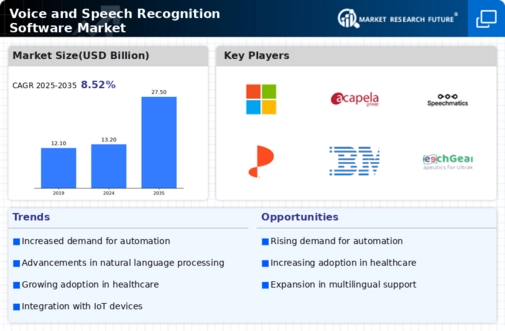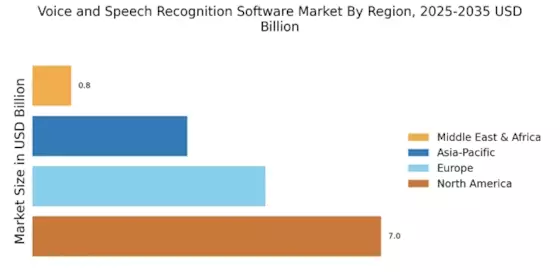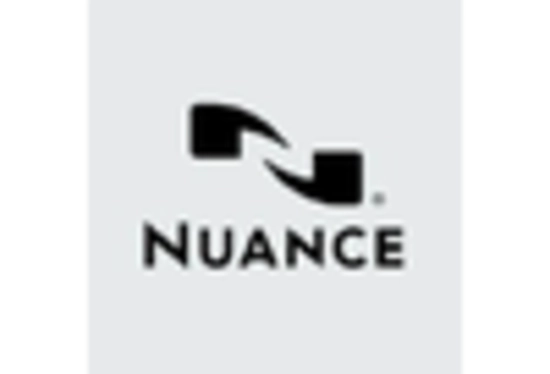The Voice and Speech Recognition Software Market is currently characterized by intense competition and rapid technological advancements. Key growth drivers include the increasing demand for automation, enhanced user experience, and the proliferation of smart devices. Major players such as Google (US), Microsoft (US), and Amazon (US) are strategically positioned to leverage their extensive resources and technological expertise. Google (US) focuses on continuous innovation in natural language processing, while Microsoft (US) emphasizes integration with its cloud services. Amazon (US) is expanding its Alexa platform, enhancing its capabilities in voice recognition. Collectively, these strategies foster a competitive environment that is both dynamic and multifaceted, as companies vie for market share through innovation and strategic partnerships.
In terms of business tactics, companies are increasingly localizing their operations to better serve regional markets, optimizing supply chains to enhance efficiency. The market structure appears moderately fragmented, with a mix of established players and emerging startups. This fragmentation allows for diverse offerings, yet the collective influence of key players like IBM (US) and Nuance Communications (US) remains substantial, as they continue to set industry standards and drive technological advancements.
In August 2025, Google (US) announced a significant upgrade to its speech recognition algorithms, enhancing accuracy and responsiveness in real-time applications. This strategic move is likely to solidify its leadership position in the market, as improved performance can lead to greater user satisfaction and increased adoption across various sectors, including healthcare and customer service. The implications of this upgrade extend beyond mere functionality; it positions Google (US) as a frontrunner in the race for AI-driven voice solutions.
In September 2025, Microsoft (US) unveiled a new partnership with a leading telecommunications provider to integrate its speech recognition technology into mobile networks. This collaboration is indicative of a broader trend towards embedding voice recognition capabilities into everyday communication tools, potentially expanding Microsoft’s reach and enhancing user engagement. Such strategic alliances are crucial in a landscape where seamless integration and user experience are paramount.
In October 2025, Amazon (US) launched a new initiative aimed at improving voice recognition for non-English languages, reflecting its commitment to inclusivity and global reach. This initiative not only broadens Amazon's market appeal but also aligns with the growing demand for multilingual support in voice technologies. By addressing diverse linguistic needs, Amazon (US) is likely to capture a larger share of the international market, further intensifying competition.
As of October 2025, current trends in the Voice and Speech Recognition Software Market are heavily influenced by digitalization, sustainability, and the integration of artificial intelligence. Strategic alliances are increasingly shaping the competitive landscape, as companies recognize the value of collaboration in driving innovation. Looking ahead, competitive differentiation is expected to evolve, with a notable shift from price-based competition towards a focus on technological innovation, reliability in supply chains, and the ability to deliver superior user experiences. This evolution underscores the importance of adaptability and foresight in navigating the complexities of the market.


















Leave a Comment